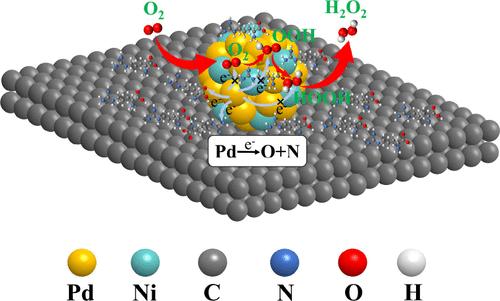l-精氨酸功能化Pd-Ni催化剂促进微反应器中H2O2的直接合成
IF 3.9
2区 化学
Q2 CHEMISTRY, MULTIDISCIPLINARY
引用次数: 0
摘要
采用l-精氨酸(LA)功能化的Pd-Ni催化剂,在常温常压下通过自行设计的微反应器直接合成过氧化氢(H2O2)。H2O2的产率为574.31g kgcat-1 h-1,溶液中H2O2的浓度为4.05 wt % / h。经过5次循环和在线活化,LA功能化的Pd-Ni催化剂保持了较高的H2O2催化活性。催化活性评价实验、表征结果和模拟研究表明,Ni掺杂和la功能化协同调节活性Pd组分的电子结构。这种调制增加了活性位点的Pd2+浓度,有效地抑制了O2*、OOH*和HOOH*中O-O键的解离,从而提高了H2O2生成的催化性能。本研究为直接合成高效H2O2的钯基催化剂的设计提供了系统的策略。本文章由计算机程序翻译,如有差异,请以英文原文为准。

l-Arginine-Functionalized Pd–Ni Catalyst Enhances Direct H2O2 Synthesis in Microreactors
Using an l-arginine (LA)-functionalized Pd–Ni catalyst, hydrogen peroxide (H2O2) was directly synthesized via a self-designed microreactor at ambient temperature and pressure. The yield of H2O2 achieved 574.31g kgcat–1 h–1, with the concentration of H2O2 in the solution reaching 4.05 wt % per hour. After five cycles and online activation, the LA functionalized Pd–Ni catalyst maintained high H2O2 catalytic activity. The catalytic activity evaluation experiments, characterization results, and simulation studies demonstrated that Ni doping and LA-functionalization synergistically modulate the electronic structure of the active Pd component. This modulation increases the concentration of Pd2+ at the active sites, effectively inhibits the dissociation of the O–O bond in O2*, OOH*, and HOOH* species, thereby enhancing the catalytic performance for H2O2 production. This study proposes a systematic strategy for the design of Pd-based catalysts to directly synthesize highly efficient H2O2.
求助全文
通过发布文献求助,成功后即可免费获取论文全文。
去求助
来源期刊

Langmuir
化学-材料科学:综合
CiteScore
6.50
自引率
10.30%
发文量
1464
审稿时长
2.1 months
期刊介绍:
Langmuir is an interdisciplinary journal publishing articles in the following subject categories:
Colloids: surfactants and self-assembly, dispersions, emulsions, foams
Interfaces: adsorption, reactions, films, forces
Biological Interfaces: biocolloids, biomolecular and biomimetic materials
Materials: nano- and mesostructured materials, polymers, gels, liquid crystals
Electrochemistry: interfacial charge transfer, charge transport, electrocatalysis, electrokinetic phenomena, bioelectrochemistry
Devices and Applications: sensors, fluidics, patterning, catalysis, photonic crystals
However, when high-impact, original work is submitted that does not fit within the above categories, decisions to accept or decline such papers will be based on one criteria: What Would Irving Do?
Langmuir ranks #2 in citations out of 136 journals in the category of Physical Chemistry with 113,157 total citations. The journal received an Impact Factor of 4.384*.
This journal is also indexed in the categories of Materials Science (ranked #1) and Multidisciplinary Chemistry (ranked #5).
 求助内容:
求助内容: 应助结果提醒方式:
应助结果提醒方式:


